Capacitors are fundamental components in electronic circuits, playing a key role in energy storage and voltage regulation. When it comes to optimizing circuit performance, understanding how to add capacitors in parallel is crucial. This technique allows you to increase the total capacitance of a circuit, which can enhance stability and efficiency.
In this article, we will delve into how to add capacitors in parallel, exploring the benefits and the straightforward process involved. By learning how to add capacitors in parallel, you’ll be able to improve your circuit designs and achieve more reliable and robust electronic systems. Ready to boost your circuit’s performance? Let’s dive into how to add capacitors in parallel and see how it can transform your projects.
What Is Parallel Capacitors?
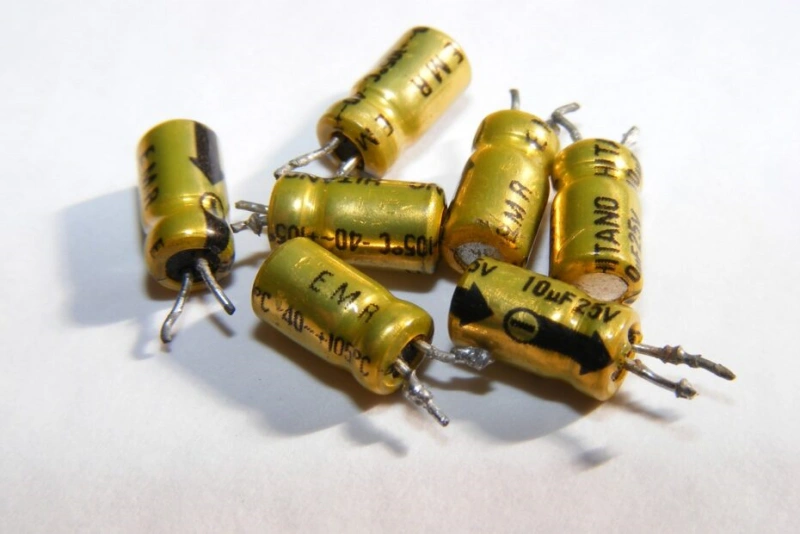
Capacitors are electronic components that store and release electrical energy. They consist of two conductive plates separated by an insulating material, called the dielectric. When voltage is applied, capacitors accumulate charge on the plates, which can then be released to maintain voltage or smooth out fluctuations.
Capacitance is a measure of a capacitor’s ability to store charge. It’s defined by the formula 𝐶=𝑄/𝑉,where C is the capacitance,Q is the charge stored, and V is the voltage across the capacitor.
When capacitors are connected in parallel, they share the same voltage across them. In this configuration, their total capacitance increases, making it easier to store more charge. The combined capacitance is the sum of the individual capacitances:Ctotal=C1+C2+C3+…
How to add capacitors in parallel? Simply connect their positive terminals together and their negative terminals together. This setup ensures that each capacitor contributes to the overall capacitance, enhancing the circuit’s ability to stabilize voltage and manage energy more effectively.
Benefits Of Adding Capacitors In Parallel
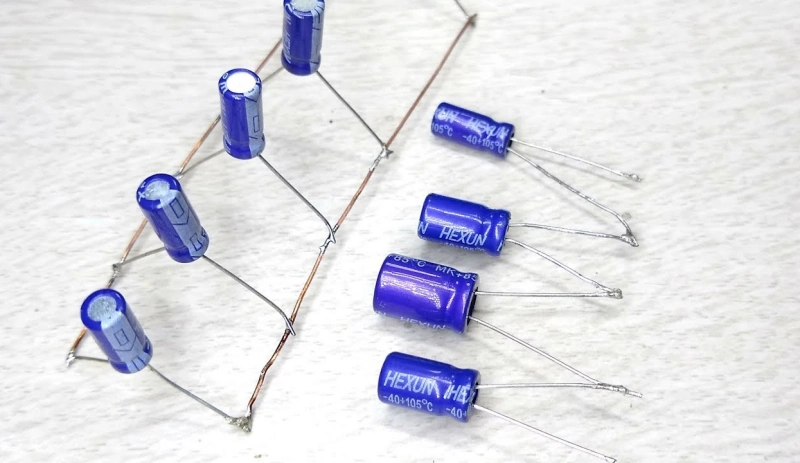
Increased Capacitance: One of the key benefits is the increase in total capacitance. When capacitors are connected in parallel, their capacitances simply add together, allowing the circuit to store more charge. This makes it a great solution when you need a higher capacitance value but only have smaller individual capacitors available.
Voltage Stability: Capacitors in parallel share the same voltage, which helps stabilize the circuit. When voltage fluctuates, the capacitors can discharge their stored energy, ensuring a consistent output. This is particularly useful in circuits sensitive to voltage drops or spikes, providing smoother performance and protecting components from potential damage.
Energy Storage: Another significant advantage is improved energy storage. The more capacitors you add in parallel, the more energy the system can hold. This is beneficial in power supply circuits or devices requiring consistent energy output.
How To Calculate Parallel Capacitor Values
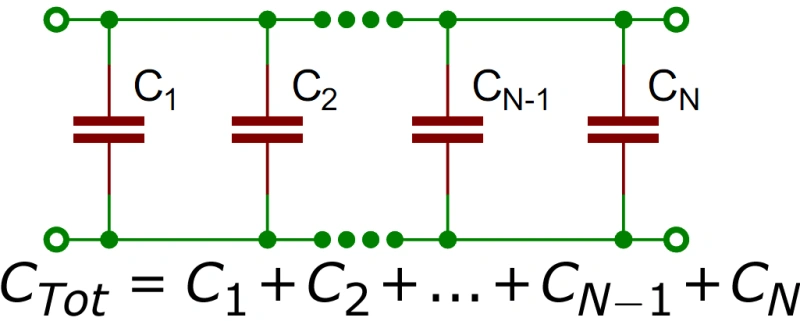
| Topic | Description |
|---|---|
| The Mathematics of Adding Capacitors in Parallel | When capacitors are added in parallel, the total capacitance is the sum of individual capacitances. This setup allows capacitors to store more charge at the same voltage. |
| Formula | The formula for calculating the total capacitance (Ctotal) in parallel: Ctotal = C₁ + C₂ + C₃ + … + Cₙ |
| Step-by-Step Example | Suppose you have three capacitors: 10µF, 20µF, and 30µF. Ctotal = 10µF + 20µF + 30µF = 60µF |
| Comparison to Series Configuration | In a series configuration, the total capacitance is calculated using the reciprocal of the sum of the reciprocals of individual capacitances, which results in lower total capacitance than in parallel. In series: 1/Ctotal = 1/C₁ + 1/C₂ + 1/C₃ + … + 1/Cₙ |
How To Add Capacitors In Parallel?
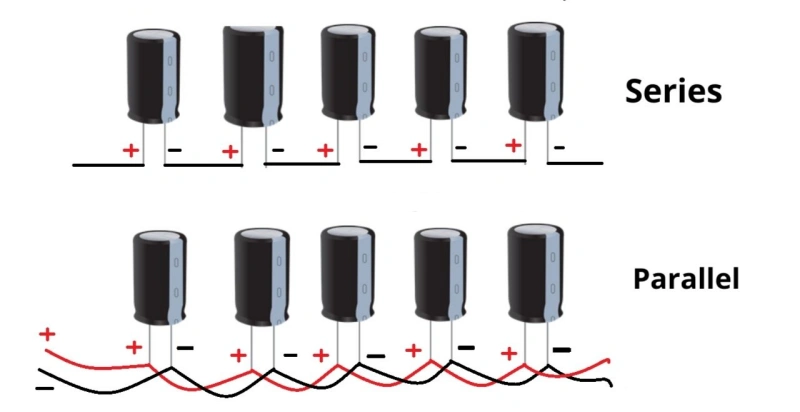
When you need to increase capacitance in a circuit, knowing how to add capacitors in parallel is crucial. Here’s a practical guide to help you do it:
How To Add Capacitors In Parallel-Materials Needed
| Materials Needed | Description |
|---|---|
| Capacitors | Ensure you have the right capacitance values for your project. |
| Wires | Short wires for connecting capacitors. |
| Breadboard or PCB | A platform to assemble your circuit. |
| Soldering Equipment | (Optional) For permanent installations. |
| Multimeter | To test the circuit. |
How To Add Capacitors In Parallel-Detailed Guide
Step 1: Identify The Capacitance Values
Start by identifying the capacitance values of your capacitors, usually labeled in microfarads (µF) or picofarads (pF). When selecting capacitors, ensure they have matching voltage ratings for consistency and safe operation. Higher capacitance means more stored charge, which directly impacts your circuit’s performance.
Step 2: Connect Capacitors
To wire capacitors in parallel, simply connect all their positive terminals together and do the same with the negative terminals. This is important because in parallel circuits, each capacitor shares the same voltage across them while their capacitance adds up. On a breadboard or PCB, you can use jumper wires to join the terminals accordingly. The process is the same regardless of the type or number of capacitors—just ensure all positive and negative leads are aligned correctly.
Step 3: Verify Connections
Once the capacitors are connected, use a multimeter to test the circuit. Set the multimeter to the capacitance measurement mode and touch the probes to the combined terminals of the parallel capacitors. This should give you a reading of the total capacitance, which should be the sum of all the individual capacitor values. If the reading is off, double-check the connections to ensure there are no shorts or miswiring.
Following these steps ensures that you have successfully added capacitors in parallel, increasing total capacitance and improving your circuit’s energy storage and stability.
Common Applications Of Parallel Capacitors
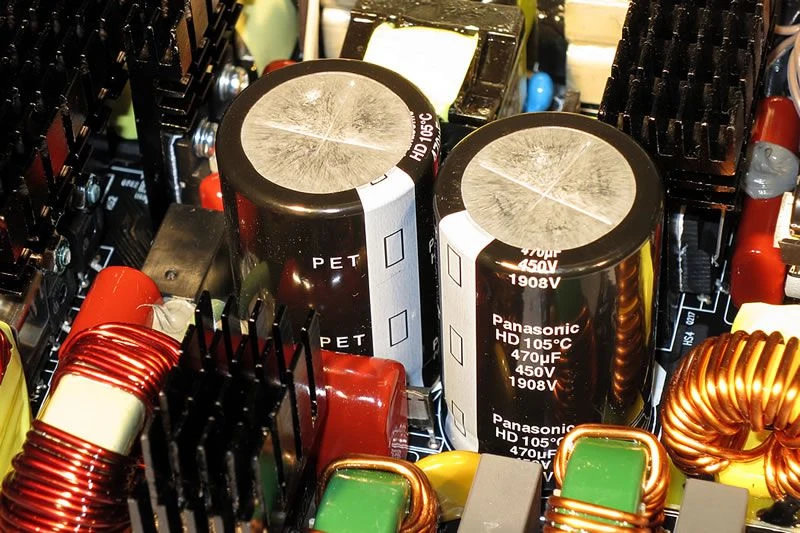
Adding capacitors in parallel is a simple yet effective technique widely used in various electronic applications. Understanding how to add capacitors in parallel can enhance your circuits by boosting capacitance and improving overall performance. Here are some of the most common applications where parallel capacitors are essential:
Power Supply Circuits
One of the primary uses for parallel capacitors is in power supply circuits. Capacitors help smooth out voltage fluctuations, ensuring that your circuit receives a steady and reliable voltage. When connected in parallel, capacitors can store more energy, making them more effective at stabilizing power levels.
This is crucial in devices like computers or smartphones, where a stable power supply prevents sudden drops or spikes in voltage that could damage sensitive components.
Signal Filtering
Parallel capacitors are also commonly used in signal filtering and signal processing. In these applications, capacitors work to filter out unwanted noise or distortions in the signal. By adding capacitors in parallel, you can fine-tune the filtering effect, allowing different frequencies to pass through while blocking interference.
This makes parallel capacitors valuable in audio circuits, communication devices, and radio systems, where clear signal transmission is critical.
Energy Storage Devices
Capacitors in parallel are often employed in energy storage devices, such as camera flashes, electric vehicles, or backup power systems. In these applications, the increased capacitance from multiple parallel capacitors allows for greater energy storage, which can then be released in short bursts when needed.
For instance, in a camera flash, parallel capacitors store enough energy to produce the intense burst of light required for a photo. Similarly, backup power systems rely on capacitors in parallel to provide temporary energy during outages. Learning how to add capacitors in parallel is vital for maximizing the efficiency of circuits in these applications, as it allows you to customize energy storage, signal clarity, and voltage stability.
Troubleshooting And Tips
Mismatched Voltage Ratings: Always ensure that the voltage ratings of capacitors are compatible with your circuit. Using capacitors with different voltage ratings can lead to failures or reduced performance. Incorrect Connections: Double-check your connections to prevent shorts or incorrect configurations.
Choosing Capacitors: Selecting the right capacitors is crucial. For general purposes, electrolytic capacitors are good for high capacitance values, while ceramic capacitors are ideal for stability and lower capacitance values. Ensure that the capacitance and voltage ratings meet your project’s needs.
Safety Considerations: Safety first! Capacitors can store electrical charge even after power is removed. Always discharge capacitors safely before handling or testing. Use a resistor to safely discharge capacitors to avoid electric shocks or damage.
How To Choose The Parallel Capacitors?
Selecting the right capacitors for adding in parallel is key to optimizing your circuit’s performance. When figuring out how to add capacitors in parallel, consider their capacitance values, voltage ratings, and tolerance. Choose capacitors with appropriate capacitance to achieve the desired total capacitance and ensure they have voltage ratings that exceed your circuit’s maximum voltage to prevent breakdown.
Additionally, match the tolerance levels to maintain consistent performance. By carefully choosing capacitors based on these criteria, you’ll enhance the effectiveness of how to add capacitors in parallel and achieve a more stable and reliable circuit.
Conclusion
In conclusion, understanding how to add capacitors in parallel is essential for enhancing your electronic circuits. By following the steps outlined, you can effectively increase total capacitance, which leads to better voltage stability and improved circuit performance. Mastering how to add capacitors in parallel allows you to tailor your circuits to meet specific needs, whether for power supply smoothing or signal filtering.
Now that you know how to add capacitors in parallel, put your knowledge to the test in your next project. Experiment with different capacitor values and configurations to see how they impact your circuit’s performance. Embrace the advantages of adding capacitors in parallel and elevate your electronic designs to the next level!